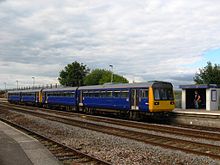- Dawlish Warren railway station
-
Dawlish Warren 

Location Place Dawlish Warren Local authority Teignbridge Coordinates 50°35′56″N 3°26′37″W / 50.59886°N 3.44354°WCoordinates: 50°35′56″N 3°26′37″W / 50.59886°N 3.44354°W Operations Station code DWW Managed by First Great Western Number of platforms 2 Live arrivals/departures and station information
from National Rail EnquiriesAnnual rail passenger usage 2002/03 * 55,275 2004/05 * 69,763 2005/06 * 74,045 2006/07 * 80,275 2007/08 * 94,252 2008/09 * 99,742 2009/10 * 114,376 History Original company Great Western Railway 1905 Opened as 'Warren Halt' 1911 Renamed 'Dawlish Warren' 1912 Resited National Rail - UK railway stations A B C D E F G H I J K L M N O P Q R S T U V W X Y Z * Annual passenger usage based on sales of tickets in stated financial year(s) which end or originate at Dawlish Warren from Office of Rail Regulation statistics. Please note: methodology may vary year on year. Dawlish Warren railway station serves the seaside resort and holiday camps of Dawlish Warren in Devon, England, at the mouth of the River Exe. The station is on the Exeter to Plymouth line 10½ miles (17 km) west of Exeter St Davids. From here to Teignmouth the railway runs along the Sea Wall.
Contents
History
No station was provided between Starcross and Dawlish until the summer of 1905 when Warren Halt was opened by the Great Western Railway.[1] This was not on the site of the present station, but nearer to the Sea Wall by the footbridge which had been built across the line in 1873.
The original 150 feet (46 m) long platforms were lengthened to 400 feet (120 m) for the next summer to allow longer trains to call. From 1 July 1907 the station was provided with offices and staff and was therefore renamed Warren Platform. It received its final name of "Dawlish Warren" on 1 October 1911.
Work soon started on a new station. A goods yard was opened on 10 June 1912 on the landward side of the line, and the new station, now 440 yards (400 m) nearer to Starcross, was opened to passengers on 23 September 1912. The platforms were now 600 feet (180 m) long. The building on the 'Down' platform (nearest the beach) was destroyed by fire on 9 January 1924.
In 1935 a camp coach was stationed in the goods yard which could be rented by holiday makers but the facility was withdrawn in 1940. Camp coaches were reintroduced in 1952, and by 1959 there were nine coaches stationed here. After 1964 the public camp coach service was withdrawn but the coaches at Dawlish Warren continued to be managed by the British Rail Staff Association for its members. The old coaches were replaced for the 1982 season by the current vehicles, since when the connection to the goods yard has been removed.
The Great Western Railway was nationalised into British Railways on 1 January 1948. Goods traffic was withdrawn on 5 August 1967 and on 3 May 1971 the station became unstaffed.[2] From 1974 to 1984 the buildings on the Up side housed the Dawlish Warren Railway Museum with its model railway. This building too burnt down in 2003, but in 2007 a new residential building was built on the site which is outwardly the same design as the former Dawlish Warren signal box. This had been located at the north end of the 'Down' platform until made redundant on 14 November 1986 by the West of England resignalling; it was demolished in May 1990.
Description
There are four tracks through the station with platforms on the outer pair which allows fast trains to overtake trains stopped at the station. Trains towards Dawlish use the platform nearest the beach, which is only a few yards away.
The station has step-free access to both platforms. A narrow and low bridge beneath the line immediately south of the station allows access between the platforms.
Behind the platform used by trains towards Paignton is a golf course and the salt marsh and dunes that make up the Dawlish Warren National Nature Reserve.
Services
Dawlish Warren is served by First Great Western trains in both directions on an approximately hourly basis during the day. Most trains run between Exmouth and Paignton; on Sundays the service is less frequent and most trains only run between Exeter St Davids and Paignton.[3] The route from Exeter St Davids through Dawlish Warren to Paignton is marketed as the "Riviera Line".
A few trains run from Bristol or from London Paddington station, otherwise passengers travelling east or north change into main line trains at St Davids, or at Newton Abbot if travelling westwards.
CrossCountry trains between the north east and south west pass through Dawlish Warren, but do not stop.
Preceding station  National Rail
National RailFollowing station Starcross First Great Western
Riviera LineDawlish References
- ^ Kay, Peter (1991). Exeter - Newton Abbot: A Railway History. Sheffield: Platform 5 Publishing. ISBN 1-8725-2442-7.
- ^ Oakley, Mike (2007). Devon Railway Stations. Wimbourne: The Dovecote Press. ISBN 1-904349-55-6.
- ^ "National Rail Timetable 135 (Winter 2007)" (PDF). Network Rail. http://www.networkrail.co.uk/browse%20documents/eNRT/Dec07/timetables/Table135.pdf.
Further reading
- Beck, Keith; Copsey, John (1990). The Great Western in South Devon. Didcot: Wild Swan Publication. ISBN 0-906867-90-8.
- Cooke, RA (1984). Track Layout Diagrams of the GWR and BR WR, Section 14: South Devon. Harwell: RA Cooke.
- Gregory, R H (1982). The South Devon Railway. Salisbury: Oakwood Press. ISBN 0-853612-86-2.
External links
This station offers access to the South West Coast Path Distance to path 50 yards (46 m) Next station anticlockwise Starcross 2 miles (3.2 km) Next station clockwise Dawlish 1.75 miles (2.8 km) Categories:- Railway stations on the South West Coast Path
- Railway stations in Devon
- Railway stations opened in 1912
- Former Great Western Railway stations
- Railway stations served by First Great Western
- DfT Category F2 stations
Wikimedia Foundation. 2010.



